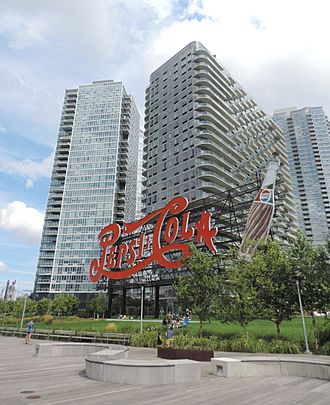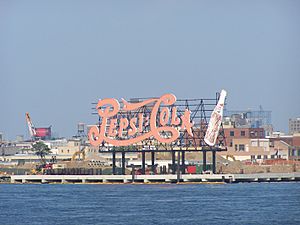Pepsi-Cola sign facts for kids
Quick facts for kids Pepsi-Cola sign |
|
|---|---|

(2015)
|
|
| General information | |
| Location | 4-09 47th Road, Long Island City, New York |
| Coordinates | 40°44′51″N 73°57′28″W / 40.74750°N 73.95778°W |
| Completed | 1940 (original) 1993 (current) |
| Design and construction | |
| Main contractor | General Outdoor Advertising Corporation (original) Artkraft Strauss (current) |
| Designated: | April 12, 2016 |
| Reference #: | 1653 |
The Pepsi-Cola sign is a famous neon sign located in Gantry Plaza State Park in Long Island City, a neighborhood in Queens, New York City. This big sign can be easily seen from Manhattan and the East River. It was first built in 1940 and placed on top of the nearby PepsiCo bottling factory. The sign shows a large Pepsi bottle and the company's name, just like the logo from when it was first made.
The original Pepsi-Cola sign was probably made by the General Outdoor Advertising Company. When it was finished, it was the longest electric sign in New York state. The picture of the Pepsi bottle on the sign was updated in the 1970s. Later, in 1993, a company called Artkraft Strauss rebuilt the sign because it was getting old. In 2003, the Pepsi factory closed down, and the sign was moved to the park where it is today. The New York City Landmarks Preservation Commission started thinking about making the sign a city landmark in 1988, and it finally became one in 2016.
Contents
What Does the Pepsi-Cola Sign Look Like?
The first sign was made by the General Outdoor Advertising Corporation. It was placed on top of the Pepsi-Cola factory in Long Island City. This sign faced west, so people in Manhattan, especially near the United Nations Headquarters, could see it.
Original Sign Details
The original sign said "Pepsi:Cola 5c" and was about 60 feet tall and 120 feet wide. It also had a huge picture of a Pepsi bottle, about 50 feet tall! The "5c" letters were blue with blue neon lights. The other letters were red with red neon lights, similar to how the sign looks now. The Pepsi bottle was about 5 inches deep and lit up by two bright lamps. When the sign was put up in 1940, Pepsi-Cola had just changed its logo. The sign's red neon lights might have been chosen because the blue outline was removed from the logo that year.
The Current Sign
The sign you see today was created by the Artkraft Strauss Sign Corporation in 1994. It also faces west towards Manhattan. The sign is built on a strong steel frame that is about 49 feet tall and 150 feet wide. The letters "Pepsi:Cola" are placed high up, almost 70 feet above the ground. These letters are painted red and silver, with thin neon light tubes around their edges. The "P" and "C" are the tallest letters, reaching about 44 feet high.
To the right of the letters is a painted silver Pepsi bottle, which also has neon lights around its edge. This bottle is 50 feet tall and looks like a Pepsi bottle from the 1970s. One small difference is that the new bottle is about 9.5 inches deep to hold electrical parts inside. The sign stands on strong foundations made of 40 deep poles that go into the solid rock below.
A Look Back: History of the Sign
Long Island City became an important place for businesses and factories in the late 1800s and early 1900s. This was because it was close to Manhattan and right on the East River. Pepsi-Cola was one of the companies that built factories there. In 1937, Pepsi bought land by the East River to make its Queens operations bigger. Before that, they had a factory further inland.
How the Sign Came to Be
The Pepsi-Cola sign was put on top of the Long Island City plant by August 30, 1940. At that time, it was advertised as the longest electric sign in New York state. City records show that the New York City Department of Buildings approved the sign in May 1940. Many factories in Long Island City were putting up big signs on their buildings around this time. These signs could be easily seen from Manhattan, the Queensboro Bridge, the Long Island Rail Road, or the elevated New York City Subway lines.
City rules back then did not allow commercial signs in neighborhoods where people lived. Later, they limited how big signs could be and how high they could be placed. These rules greatly affected where companies could put their signs.
Changes Over Time
The "5c" part of the sign was removed in the mid-1940s when the price of Pepsi-Cola went up. The design of the bottle on the sign was updated around the 1970s to match newer Pepsi bottles. By the end of the 20th century, many factories along the Long Island City waterfront started moving away. The area was planned to be redeveloped as part of a big project called Queens West.
The New York City Landmarks Preservation Commission (LPC) first thought about making the sign a city landmark in April 1988. A PepsiCo spokesperson said that the sign was "almost an icon," meaning it was very famous. Because of this, the company chose not to update the sign to match its modern logo. The borough president of Queens, Claire Shulman, suggested moving the sign because it might get in the way of the Queens West development. However, PepsiCo disagreed, saying they owned the sign and decided what happened to it. The LPC did not vote on making it a landmark at that time. Until the late 1990s, the LPC had never made a single sign an individual city landmark.
Rebuilding and Landmark Status
The original sign was almost completely destroyed in a big storm in December 1992. By the end of 1993, the entire sign had been taken down. Artkraft Strauss rebuilt the sign in their Manhattan factory, making the letters look just like the original sign. A city spokesperson said that changing the sign would mean "losing a little bit of the texture of New York." Because the LPC was still considering the sign as a landmark, they had to approve parts of the rebuilding process.
By 2000, PepsiCo announced they would be leaving their bottling factory. PepsiCo, the Queens West project, and the LPC all wanted the Pepsi-Cola sign to be saved. The LPC held another meeting to discuss preserving the sign. PepsiCo moved all its Queens operations to College Point. The old PepsiCo factory site then became part of the northern section of Gantry Plaza State Park.
PepsiCo sold its bottling plant in 2003. However, the company made sure that the sign would stay on the Long Island City waterfront. They kept ownership of the sign and a piece of land near their old factory just for the sign. In 2004, the PepsiCo sign was moved about 300 feet south, next to Gantry Plaza State Park, and a new base was built for it. This temporary move was needed because the factory was being torn down and the park was being built. A photographer named Vera Lutter took pictures of the sign being moved.
The sign was then moved back to its original position in 2008. It was taken apart in late 2008 to get ready for its final reinstallation. In early 2009, the sign was put back together in its permanent spot in Gantry Plaza State Park. PepsiCo continues to take care of the sign. A building nearby, 46-10 Center Boulevard, was designed so that its lower floors were set back. This was done to make sure the building did not block the view of the sign.
In late 2015, the LPC held a public meeting about making the Pepsi-Cola sign a city landmark. Most people supported the idea, but some, including the sign's owner, did not. This was part of a review of many old listings that the LPC had been considering for decades but had not yet approved. The Pepsi-Cola sign was officially named a New York City landmark in June 2016. Usually, landmarks have to be at least 30 years old. However, even though the sign was rebuilt, its design was very accurate to the original sign that was destroyed.


